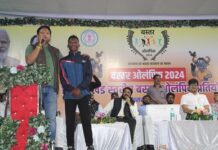The ‘BJP Bhagao, Desh Bachao‘ rally, called by the Lalu Prasad Yadav-led Rashtriya Janata Dal (RJD) in Patna on Sunday, had assumed great significance, especially after the Mahagathbandhan government in Bihar, comprising the RJD and Janata Dal (United), collapsed last month. Projected to showcase opposition strength in the face of that debacle, it was the first such gathering of various political parties and their supporters. The grand call to “oust the BJP and save the country” at a time when the saffron party is in power in all the north Indian states, except Himachal Pradesh, Delhi and Punjab, was not only viewed as gutsy but also one of the the first serious attempts to launch a full-scale spirited attack on the National Democratic Alliance (NDA), which has been profiting from a disarrayed opposition.
As news came in, the rally, in which thousands of people participated, was indeed a huge success. Joined by the Congress, Samajwadi Party (SP), Trinamool Congress (TMC), Dravida Munnetra Kazhagam (DMK), Communist Party of India (CPI), Revolutionary Socialist Party, Nationalist Congress Party (NCP), Janata Dal (Secular), Jharkhand Mukti Morcha (JMM), Jharkhand Vikas Morcha (JVM), Assam-based All India United Democratic Front and a section of Janata Dal (United) led by rebel leaders Sharad Yadav and Ali Anwar, the rally presented a leadership that represented all corners of India. United in its opposition to communalism and NDA’s alleged poor governance over the last three years, the rally signalled that the opposition’s way forward to take on the BJP would be on these two counts.
However, the question that comes up at present is whether this show of unity is too little too late? In other words, will this opposition unity prove to be sufficient in derailing the BJP’s muscular bandwagon in 2019 general election?
The question assumes importance because of three reasons.
One, in the last three years, the Narendra Modi government has outsmarted the opposition in all possible ways. It has captured the political narrative of Indian polity in an unprecedented way. The talks of a united opposition have been doing the rounds ever since the BJP came to power. But none of these stray efforts materialised.
The state-level parties are too entangled in regional politics and are battling their own demons. For instance, with a raging feud between Mulayam Singh Yadav and Akhilesh Yadav, the SP has its own house to clean first.
Similarly, the RJD’s perception as a corrupt and dynastic party will prove to be a roadblock for its success. The NCP, too, has had a love-hate relationship with the secular alliance in the last three years. Congress, the only national party, on the other hand, is facing its worst ever crisis. Regional players like the TMC, DMK, JD(S), JMM or JVM are too enmeshed in state politics to lead the opposition struggle. The breakaway faction of JD(U) does not have any mass support to claim as its own. The Left parties, too, have to resolve their intra-party ideological debate before being seen as a credible national force to take on the BJP.
Although the success of the rally provides a way forward for the opposition both strategically and tactically, it would require a huge amount of investment for the opposition leaders to set aside their myopia and launch a concerted ideological attack against the BJP. One cannot ignore the fact the Bahujan Samaj Party (BSP) and the biggest leftist force, the Communist Party of India (Marxist), chose to remain outside this show of strength.
If any opposition in the last three years has made the Modi government uncomfortable, it is the independent Dalit movements across the country and Leftist opposition in states like Kerala and Tripura. The inability of the opposition leaders to convince natural allies like the BSP and the CPI(M) to join Sunday’s rally may prove to be the Achilles’s heel of such a grand alliance.
Unlike the Mahagathbandhan, none of these parties which participated in the rally will form a formidable opposition to the BJP in different states, even if they contest together. With such low electoral significance, the parties may find it difficult to stick together if they do not unite on a common minimum agenda, which is currently missing in the scheme of things.
Two, the opposition leaders have always needed a strong jolt to act. Until the time the Mahagathbandhan government won in Bihar, a large part of the opposition remained unimaginative and laced with chronic lethargy. It was only after the RJD-JD(U) alliance won with a handsome majority, the idea of an opposition unity dawned upon BJP’s adversaries. One may recall that Lalu Prasad Yadav, immedaitely after winning the Bihar assembly polls, had announced grandiosely that he would launch a nation-wide movement against the BJP with the help of opposition leaders, only to dive into greater complacency. It took the collapse of the government and a shrewd escape of Nitish Kumar, who was being projected as the leader of the opposition unity, from the opposition fold to shake up the leaders again.
Three, while the BJP has been campaigning to consolidate Hindus, irrespective of caste and sects, at the cost of minorities, the opposition leaders have not been able to think at this large a scale. Most of them still rely on their traditional caste-based supporters and are trying to forge ground level alliances on that basis. The temporary success of Mahagathbandhan reaffirmed their old beliefs; however with its failure, the opposition may have to look at other possibilities.
In such a political context, the BJP, therefore, found it very convenient to overlook the mass support the rally received on Sunday and label the opposition unity as an alliance of the corrupt. Such rhetoric of the BJP, if not countered immediately, will reduce the Indian polity into two representational poles that are devoid of any real socio-economic agenda. This may help the BJP in its agenda of Hindu consolidation, a possibility that the opposition cannot ignore if it is serious about taking on the BJP in 2019.
Despite the cat and mouse game, the opposition unity project is off to a commendable start, if the rally is taken as a parameter. It has raised hopes and aspirations among people who are reeling under the pressure of rising unemployment and back-breaking price rise. Now that the opposition appears to have consolidated this support – irrespective of caste and communitarian equations – and hopes to bring in Dalits and other minority groups into this fold, it has the task of ensuring that the unity lasts.
But for that to happen, it has to first bury its myopic political interests and then re-imagine itself as a broader political alternative to the BJP’s agenda. The twin themes of communalism and alleged poor governance under the BJP regime at the crux of the opposition’s campaign may be at the right place, but in the end, it is merely a critique. Its biggest challenge would be to successfully offer a comprehensive socio-economic agenda, set within a political narrative that is perceptively different from the saffron party’s.















